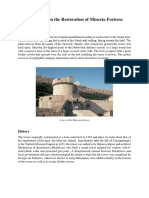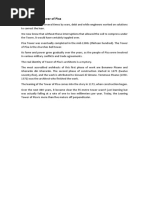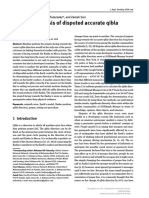0 ratings0% found this document useful (0 votes)
23 viewsTugas PPT Kelompok 11
Tugas PPT Kelompok 11
Uploaded by
jayansyaharilThe Tower of Pisa began construction in 1173 but developed a tilt due to unstable clay soil underneath the foundations. Construction halted after only a few levels were built due to the emerging lean. In 1272 construction resumed in an attempt to compensate for the existing tilt, but this only made the problem worse. The tower was finally completed in the mid-14th century but continued tilting further in the following centuries due to ongoing soil shifts beneath the weak foundations. Modern restoration efforts aim to stabilize the tower and reduce additional tilting so it remains standing for visitors to admire.
Copyright:
© All Rights Reserved
Available Formats
Download as PPTX, PDF, TXT or read online from Scribd
Tugas PPT Kelompok 11
Tugas PPT Kelompok 11
Uploaded by
jayansyaharil0 ratings0% found this document useful (0 votes)
23 views5 pagesThe Tower of Pisa began construction in 1173 but developed a tilt due to unstable clay soil underneath the foundations. Construction halted after only a few levels were built due to the emerging lean. In 1272 construction resumed in an attempt to compensate for the existing tilt, but this only made the problem worse. The tower was finally completed in the mid-14th century but continued tilting further in the following centuries due to ongoing soil shifts beneath the weak foundations. Modern restoration efforts aim to stabilize the tower and reduce additional tilting so it remains standing for visitors to admire.
Original Description:
Semangat kuliahnya tugas bahasa Inggris untuk mahasiswa.
Original Title
TUGAS PPT KELOMPOK 11
Copyright
© © All Rights Reserved
Available Formats
PPTX, PDF, TXT or read online from Scribd
Share this document
Did you find this document useful?
Is this content inappropriate?
The Tower of Pisa began construction in 1173 but developed a tilt due to unstable clay soil underneath the foundations. Construction halted after only a few levels were built due to the emerging lean. In 1272 construction resumed in an attempt to compensate for the existing tilt, but this only made the problem worse. The tower was finally completed in the mid-14th century but continued tilting further in the following centuries due to ongoing soil shifts beneath the weak foundations. Modern restoration efforts aim to stabilize the tower and reduce additional tilting so it remains standing for visitors to admire.
Copyright:
© All Rights Reserved
Available Formats
Download as PPTX, PDF, TXT or read online from Scribd
Download as pptx, pdf, or txt
0 ratings0% found this document useful (0 votes)
23 views5 pagesTugas PPT Kelompok 11
Tugas PPT Kelompok 11
Uploaded by
jayansyaharilThe Tower of Pisa began construction in 1173 but developed a tilt due to unstable clay soil underneath the foundations. Construction halted after only a few levels were built due to the emerging lean. In 1272 construction resumed in an attempt to compensate for the existing tilt, but this only made the problem worse. The tower was finally completed in the mid-14th century but continued tilting further in the following centuries due to ongoing soil shifts beneath the weak foundations. Modern restoration efforts aim to stabilize the tower and reduce additional tilting so it remains standing for visitors to admire.
Copyright:
© All Rights Reserved
Available Formats
Download as PPTX, PDF, TXT or read online from Scribd
Download as pptx, pdf, or txt
You are on page 1of 5
History
and Causes of the
Leaning of the Tower
E1F123051 AL AMIN
E1F123052 ANDREAS DICKY JAN
E1F123053 ARIL JAYANSYAH
E1F123054 FATMAWATI
E1F123055 FEBRIANTI TAMRIN
Tower of Pisa
1. The Tower of Pisa is a bell tower-shaped structure known for its striking
tilt. The Tower of Pisa is located in the Piazza dei Miracoli (Magic Square),
also known as Piazza del Duomo, in the Italian city of Pisa. Piazza dei
Miracoli is a collection of beautiful and important cathedral buildings,
including Pisa Cathedral.
2. The Tower of Pisa has a height of approximately 55.86 meters from ground
level to its peak. At the top, the tilt can reach around 5.5 degrees. The Tower
of Pisa is a popular and famous tourist destination throughout the
world. Many tourists come here to see the tower and take photos in creative
poses to show its tilted optical effect.
3. In the 1990s, restoration and repair efforts were undertaken to prevent the
tower's tilt from getting worse and to ensure safety for visitors. In addition,
there is a limit on the number of visitors allowed to climb into the tower
each day.
History of the Tower of Pisa
The history of the Tower of Pisa begins in 1173 when construction began, and its journey has been full
of challenges and events that have made it one of the most iconic and famous buildings in the world
Initial Construction (1173-1178)
Construction of the Tower of Pisa began on August 9, 1173. At that time, the city of Pisa was one of the leading maritime cities in Italy,
and the building was planned as a large bell for the Pisa Cathedral located in Piazza dei Miracoli . However, construction stopped after
completing three layers of foundation due to unstable soil.
Construction Continues (1272-1350)
After various obstacles and the passage of a long time, in 1272, the Pisa Government decided to continue construction of the Pisa
Tower. At this time, the architects involved in the project designed the tower in tandem, attempting to compensate for the tilt that had
occurred.
Completion and Restoration (1350s and After)
Although the tower was completed in the mid-14th century, the decision to continue construction caused the tower to lean. Even though
it is tilted, this tower still functions as a bell for Pisa Cathedral. In the following centuries, the tower slowly continued to tilt further due
to shifts in the ground. In the 1990s, a restoration and salvage project was undertaken to reduce the tilt and ensure the safety of the
structure and visitors.
Global Recognition (20-21 Century)
The Tower of Pisa has become one of the most famous icons in the world. Visitors from all over the world come to see the tower and
take photos in creative poses that exploit its tilt. In 1987, Piazza dei Miracoli, which includes the Tower of Pisa, was recognized by
UNESCO as a World Heritage Site.
So why is the Pisa Tower
The Pisa Tower is leaning due to problemsleaning?
in its construction and the ground beneath
it. When construction began in 1173, the foundations built on soft, clayey soil began to
experience problems. Here are some factors that cause the Tower of Pisa to tilt:
Clay Soil
The Pisa site is located near the Arno river, and the soil in this area consists of layers of clay and silt. Clay soil tends to
be unstable and is able to move and absorb water easily .
Too Deep Foundations
The foundations for the Tower of Pisa were only buried about three meters below ground level. This foundation is
placed directly on a layer of clay soil. Deeper, more stable foundations may have reduced the potential for tilt.
Problems During Construction
After the first three foundation layers were completed, the construction team began to notice undesirable shifts. They
tried to compensate for the tilt by building each subsequent layer of foundation slightly higher on the lower side, but this
was not entirely successful.
The Slant Continues
Although construction stalled for several decades, when building resumed in the 13th century, the slant was already
quite significant. Efforts to compensate for the tilt have provided some improvement, but the core problem remains.
Tower Tilt
Ultimately, the Leaning Tower of Pisa tilted about 5.5 degrees from vertical. This is the result of weak foundations and
shifting soil beneath them .
THANK
S
CREDITS: This presentation template was created by
Slidesgo, and includes icons by Flaticon, and
infographics & images by Freepik
You might also like
- Time Line Study On Method of Construction and Materials of Construction.Document5 pagesTime Line Study On Method of Construction and Materials of Construction.Angel Joy TiabaNo ratings yet
- Heldannic OrderDocument66 pagesHeldannic OrderParaplegic Racehorse100% (7)
- The Leaning Tower of PisaDocument4 pagesThe Leaning Tower of Pisayyuui7896No ratings yet
- The Leaning Tower of Pisa Original 2Document20 pagesThe Leaning Tower of Pisa Original 2womgyoyiNo ratings yet
- The Leaning Tower of PisaDocument7 pagesThe Leaning Tower of Pisayasmineabubeker768No ratings yet
- Why Does The Tower of Pisa LeanDocument2 pagesWhy Does The Tower of Pisa LeantwisharoychowdhuryNo ratings yet
- All About Leaning Tower of Pisa: A Kid's Guide to Italy's Most Famous Tilted Building: Educational Books For Kids, #23From EverandAll About Leaning Tower of Pisa: A Kid's Guide to Italy's Most Famous Tilted Building: Educational Books For Kids, #23No ratings yet
- The Leaning TowerDocument6 pagesThe Leaning TowerLuis Camilo SánchezNo ratings yet
- Leaning Tower of Pisa - La Torre deDocument8 pagesLeaning Tower of Pisa - La Torre dezozomaherNo ratings yet
- The Leaning Tower of PisaDocument6 pagesThe Leaning Tower of PisaPrincess Yram Nna TimosaNo ratings yet
- Pisa Italy: Leaning Tower of Pisa, ItalianDocument2 pagesPisa Italy: Leaning Tower of Pisa, ItaliansonukuldeepNo ratings yet
- Describe A BuildingDocument3 pagesDescribe A BuildingGresiShemaNo ratings yet
- D. Leaning Tower of PisaDocument3 pagesD. Leaning Tower of PisaantoNo ratings yet
- Geometry Project EssayDocument2 pagesGeometry Project Essayapi-194738246No ratings yet
- The Leaning Tower of Pisa, The Symbol of The City of Pisa in ItalyDocument7 pagesThe Leaning Tower of Pisa, The Symbol of The City of Pisa in ItalyӘділ МадығұлNo ratings yet
- Leaning Tower of PisaDocument1 pageLeaning Tower of PisaGilbert SyaranamualNo ratings yet
- Manual Lego Pisa 6049003Document100 pagesManual Lego Pisa 6049003Ángel L. RamosNo ratings yet
- English Exercise N°1Document9 pagesEnglish Exercise N°1Anfel BelmeguenaiNo ratings yet
- Torre Pendente Di PisaDocument4 pagesTorre Pendente Di PisaSahar KefiNo ratings yet
- Case Study 1Document6 pagesCase Study 1CIELO MARIE MANAOISNo ratings yet
- Tower of Pisa: Standing Tall 185 Feet in The Air, TheDocument4 pagesTower of Pisa: Standing Tall 185 Feet in The Air, TheMohamed FirthousNo ratings yet
- TerjemahanDocument2 pagesTerjemahanSamuel_Ricky_7155No ratings yet
- 11PCMP Shubh Kansal - Assignment NotemakingDocument2 pages11PCMP Shubh Kansal - Assignment Notemakingshubhkansal75No ratings yet
- Hanoi Open University: Faculty of TourismDocument15 pagesHanoi Open University: Faculty of TourismThúy PhươngNo ratings yet
- Learn how the famous tower is still standing against all oddsDocument1 pageLearn how the famous tower is still standing against all oddsNou SaïbãNo ratings yet
- Пизанская башняDocument4 pagesПизанская башняjobas54343No ratings yet
- Tower of PisaDocument1 pageTower of PisaKristiana AmorenNo ratings yet
- Why Doesnt The Leaning Tower of Pisa Fall OverDocument2 pagesWhy Doesnt The Leaning Tower of Pisa Fall OverHải ĐôngNo ratings yet
- ARCHIDocument1 pageARCHIallanalido23No ratings yet
- The Leaning Tower of PisaDocument18 pagesThe Leaning Tower of PisaSohail MaqboolNo ratings yet
- The Leaning Tower of PisaDocument2 pagesThe Leaning Tower of PisaHekmatYar AkhundNo ratings yet
- The Leaning Tower of PisaDocument15 pagesThe Leaning Tower of PisaThanh NgânNo ratings yet
- Soap 2 JB BurlandDocument13 pagesSoap 2 JB BurlandKarim TaherNo ratings yet
- Leaning Tower of PisaDocument1 pageLeaning Tower of PisasonukuldeepNo ratings yet
- Tower of PisaDocument1 pageTower of PisaAlina Gabriela PetreNo ratings yet
- The Leaning Tower of PisaDocument4 pagesThe Leaning Tower of PisaGrace TranNo ratings yet
- THE TOWER OF PISA WorkDocument8 pagesTHE TOWER OF PISA WorkScribdTranslationsNo ratings yet
- Why Does The Leaning Tower of Pisa Lean? Miert Ferde A Pisai Ferde Torony?Document1 pageWhy Does The Leaning Tower of Pisa Lean? Miert Ferde A Pisai Ferde Torony?andreaNo ratings yet
- The Leaning Tower of PisaDocument4 pagesThe Leaning Tower of Pisafigenergurbuz1980No ratings yet
- Case Study of Differential Settlement On Leaning Tower of PisaDocument5 pagesCase Study of Differential Settlement On Leaning Tower of PisaKabiraj KhatriNo ratings yet
- The Leaning Tower of PisaDocument4 pagesThe Leaning Tower of PisaNabil AlfauziNo ratings yet
- Duomo), After The Cathedral and The Pisa BaptistryDocument3 pagesDuomo), After The Cathedral and The Pisa Baptistrylachel joy tahinayNo ratings yet
- The Leaning Tower of Pisa RevisitedDocument14 pagesThe Leaning Tower of Pisa RevisitedAmbujNo ratings yet
- The Leaning Tower of Pisa: Submitted By: Prathamesh Mane Submitted To: Prof. Shruti PantDocument18 pagesThe Leaning Tower of Pisa: Submitted By: Prathamesh Mane Submitted To: Prof. Shruti PantNidhi MehtaNo ratings yet
- Case 3: Leaning Tower of Pisa-Torre Pendente Di Pisa, ItalyDocument4 pagesCase 3: Leaning Tower of Pisa-Torre Pendente Di Pisa, ItalyVishweshwaran MNo ratings yet
- The Leaning Tower of Pisa: Cathedral Pisa Foundation Pisa CathedralDocument1 pageThe Leaning Tower of Pisa: Cathedral Pisa Foundation Pisa CathedralMaxcraft MDNo ratings yet
- The Leaning Tower of Pisa: Civil 3rd Ye ArDocument18 pagesThe Leaning Tower of Pisa: Civil 3rd Ye Armonika chauhanNo ratings yet
- Leaning Tower of PisaDocument23 pagesLeaning Tower of Pisaanil kumarNo ratings yet
- The Leaning Tower of PisaDocument4 pagesThe Leaning Tower of PisaMarinaRodriguezNo ratings yet
- Leaning Tower of Pisa (Report)Document6 pagesLeaning Tower of Pisa (Report)Gillian Adona100% (1)
- Restoration Ca2 Samira Ali PDFDocument17 pagesRestoration Ca2 Samira Ali PDFBLOOMNo ratings yet
- Leaning tower of PisaDocument8 pagesLeaning tower of Pisamichong041112No ratings yet
- Torre de PisaDocument9 pagesTorre de Pisalomas3No ratings yet
- 1 - Basilica Di San VitaleDocument61 pages1 - Basilica Di San VitaleLam Bao Khanh PhanNo ratings yet
- Reading Material 3Document1 pageReading Material 3paulinus995No ratings yet
- On-Site Investigation and Monitoring For The Assessment of A Historic Brick Masonry TowerDocument10 pagesOn-Site Investigation and Monitoring For The Assessment of A Historic Brick Masonry TowerRyo ShinNo ratings yet
- On Ancient &modern Architectural SplendidsDocument22 pagesOn Ancient &modern Architectural SplendidsKishoreNo ratings yet
- Geotechnical Engineering and Leaning Tower of Pisa: Indian Geotechnical Society Silchar Student Chapter (IGSSSC)Document1 pageGeotechnical Engineering and Leaning Tower of Pisa: Indian Geotechnical Society Silchar Student Chapter (IGSSSC)Rashid ShamsNo ratings yet
- History of The Tower PisaDocument3 pagesHistory of The Tower PisaPaola Delgado SaldañaNo ratings yet
- TF2821 CH01Document12 pagesTF2821 CH01Mostafa AtefNo ratings yet
- Types of Topo SheetsDocument7 pagesTypes of Topo SheetsManmath KewaliyaNo ratings yet
- Flood: Estimation For Small East African Rural CatchmentsDocument14 pagesFlood: Estimation For Small East African Rural CatchmentsafbafbNo ratings yet
- Africa Countries - Map Quiz Game - SeterraDocument1 pageAfrica Countries - Map Quiz Game - SeterramaraNo ratings yet
- Draft SOP Urban Resurvey 051124Document147 pagesDraft SOP Urban Resurvey 051124ramsai.franlNo ratings yet
- Dichotomy in Physical and Human Geography(English.pdf)Document3 pagesDichotomy in Physical and Human Geography(English.pdf)RoseNo ratings yet
- Mahindra United World College of India by Christopher Charles Benninger - A Self-Sufficient CampusDocument31 pagesMahindra United World College of India by Christopher Charles Benninger - A Self-Sufficient CampusChanchal SoniNo ratings yet
- SST Grade 9 Term 1 Opener Exams s1&2Document15 pagesSST Grade 9 Term 1 Opener Exams s1&2Loxxy Zoom100% (1)
- 7 - Rocks Become SoilDocument8 pages7 - Rocks Become SoillamaNo ratings yet
- List of Countries by The UN Geoscheme - Google SheetsDocument14 pagesList of Countries by The UN Geoscheme - Google SheetsPacir QubeNo ratings yet
- Dada CSVDocument2,181 pagesDada CSVpranithNo ratings yet
- AoF - Dark Crusade (Mission Pack 1) v3.1.0Document22 pagesAoF - Dark Crusade (Mission Pack 1) v3.1.0giovannismNo ratings yet
- Airport Drainage: by SrinivasDocument38 pagesAirport Drainage: by Srinivasayoushika abrolNo ratings yet
- Solar AltitudeDocument2 pagesSolar AltitudeManjusa BhuyanNo ratings yet
- ICSE Class 7 Geography Sample Paper Set 1Document5 pagesICSE Class 7 Geography Sample Paper Set 1naadiralamNo ratings yet
- Sorin Fortiu Geodetic Statistical Analysis Just A ClassicGIGODocument30 pagesSorin Fortiu Geodetic Statistical Analysis Just A ClassicGIGObogdan alexandruNo ratings yet
- Social Studies 02.04Document21 pagesSocial Studies 02.04Joshua NikkelNo ratings yet
- A Solar Observation Was Made in The Afternoon and The Following Quantities Have Been DeterminedDocument5 pagesA Solar Observation Was Made in The Afternoon and The Following Quantities Have Been DeterminedfrancishozeguevaraNo ratings yet
- Question Paper - Periodic Assesement 3 MCQ'sDocument5 pagesQuestion Paper - Periodic Assesement 3 MCQ'spinkypinkyponkyNo ratings yet
- Class Subject Title Author (S) Publisher Price: Peace - Work - Fatherland Paix - Travail - PatrieDocument12 pagesClass Subject Title Author (S) Publisher Price: Peace - Work - Fatherland Paix - Travail - PatrieYves JuannyNo ratings yet
- 362 Volcanic Rifted MarginsDocument231 pages362 Volcanic Rifted MarginsEdwin Yudha NugrahaNo ratings yet
- Branches of Social ScienceDocument1 pageBranches of Social ScienceCzarina BernalesNo ratings yet
- Indigenous Lesson PlansDocument9 pagesIndigenous Lesson Plansapi-511602296No ratings yet
- 05-Ab-108 Social Panorama (A Book of Social Studies) Class-5Document138 pages05-Ab-108 Social Panorama (A Book of Social Studies) Class-5farhanrizwi2008No ratings yet
- Cambridge English - Advanced - Cae - Use of English - Multiple Choice Cloze - Test 20Document5 pagesCambridge English - Advanced - Cae - Use of English - Multiple Choice Cloze - Test 20Sentido Común Alternativo SCANo ratings yet
- Canadá: Integrantes: Polet Obando Paula Cifuentes Eileen Muñoz Profesora: Ilse SaavedraDocument19 pagesCanadá: Integrantes: Polet Obando Paula Cifuentes Eileen Muñoz Profesora: Ilse SaavedrasemofuNo ratings yet
- Geography Subject For Middle School - Exploring Maps and Landforms by SlidesgoDocument55 pagesGeography Subject For Middle School - Exploring Maps and Landforms by Slidesgochu che béNo ratings yet
- Stormwater Inundation Analysis in Small and Medium Cities For The Climate Change Using EPA-SWMM and HDM-2DDocument6 pagesStormwater Inundation Analysis in Small and Medium Cities For The Climate Change Using EPA-SWMM and HDM-2DNur Shukria Hidayah HiulNo ratings yet
- Writer's Effect QsDocument1 pageWriter's Effect QsHuma EssaNo ratings yet
- Geodetic Analysis of Disputed Accurate Qibla Direction: Tono Saksono, Mohamad Ali Fulazzaky, and Zamah SariDocument10 pagesGeodetic Analysis of Disputed Accurate Qibla Direction: Tono Saksono, Mohamad Ali Fulazzaky, and Zamah SariBadrun TamanNo ratings yet

























































































